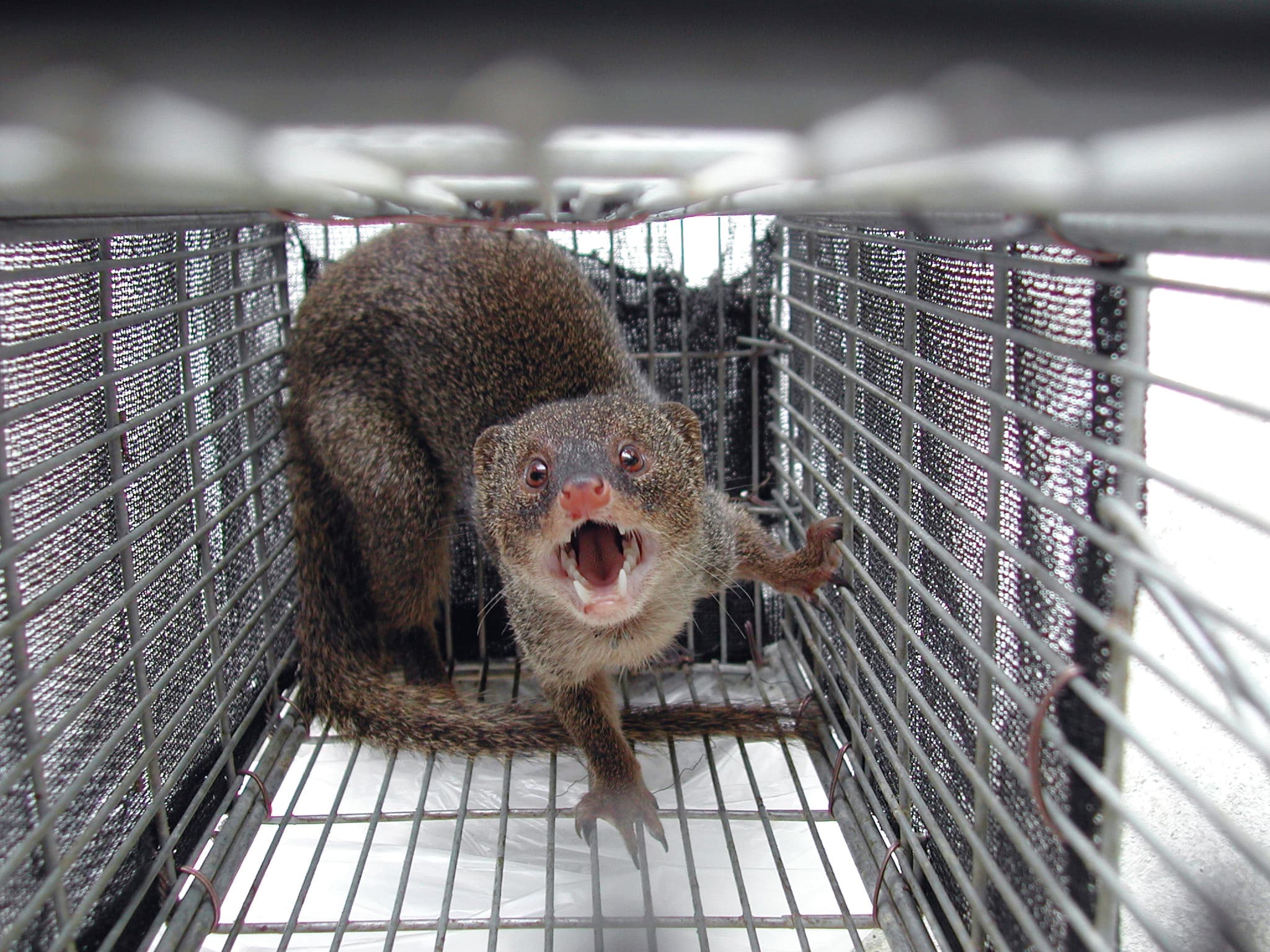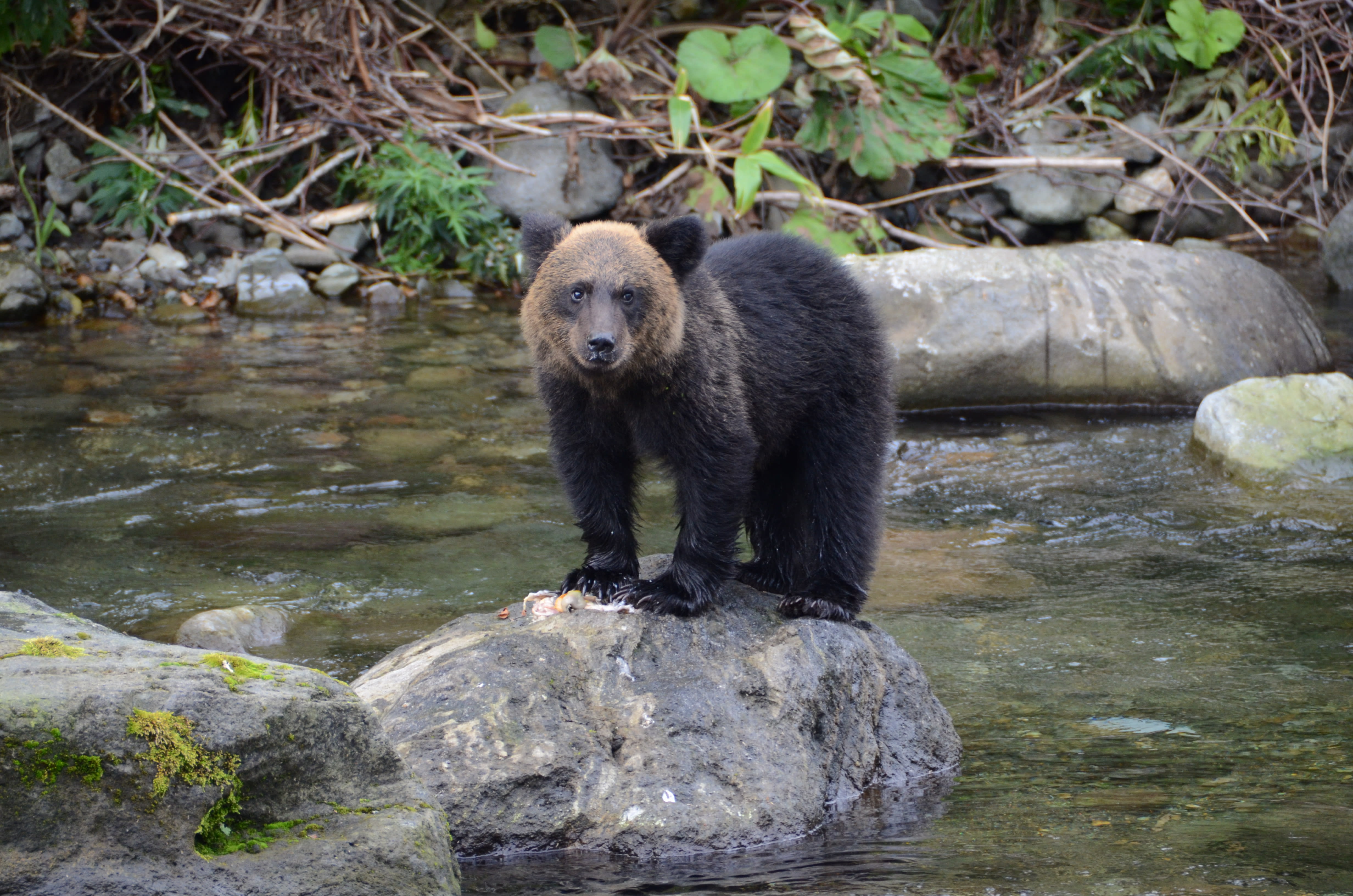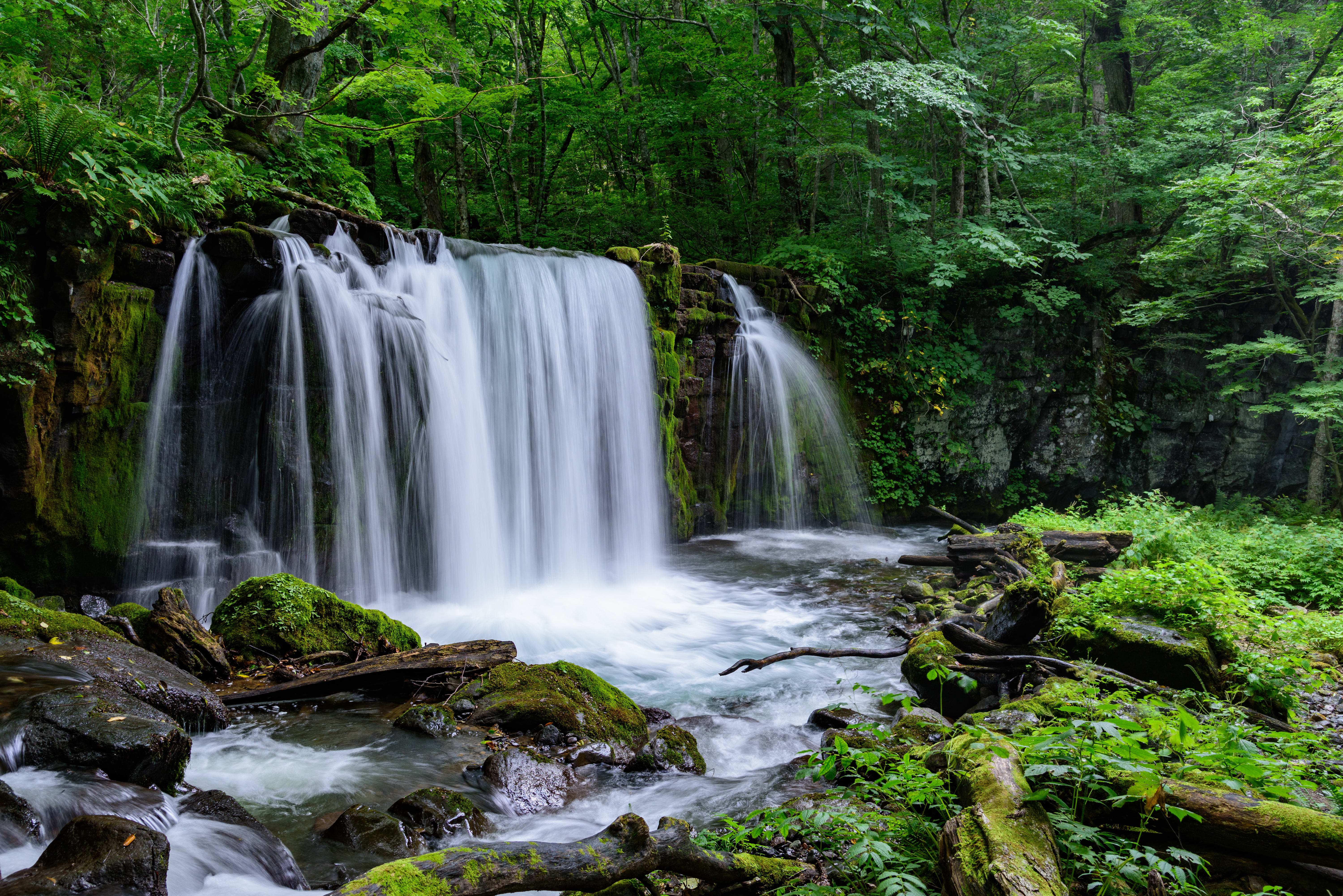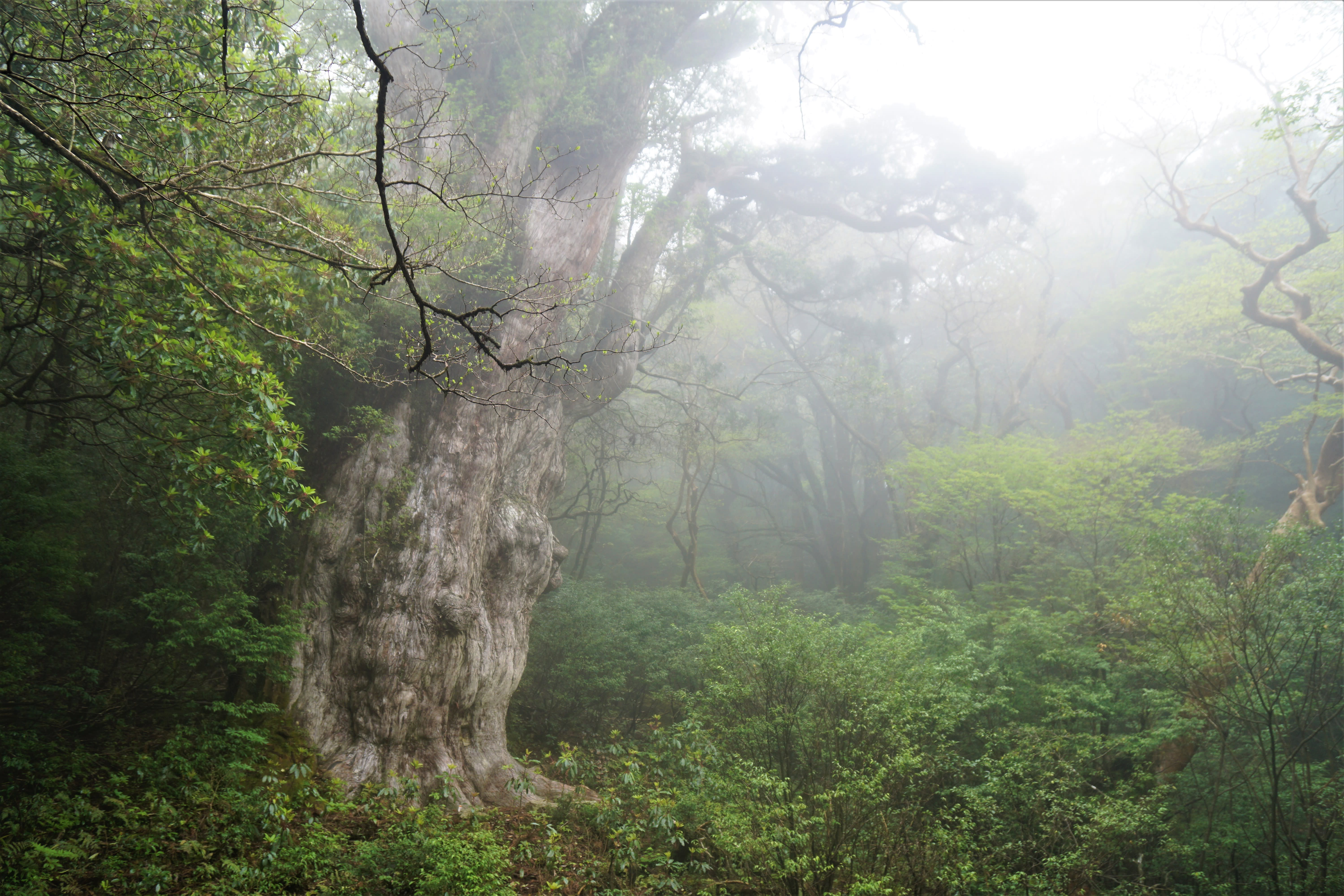
National parks and other protected areas play a vital role in protecting plant and animal species such as the endangered Amami Ishikawa’s frog
Amami/Okinawa
“Amami-Oshima Island, Tokunoshima Island, Northern part of Okinawa Island, and Iriomote Island” (Amami/Okinawa) encompasses several of the subtropical Ryukyu Islands and are scattered over a range of 1,200 km from the south of Kyushu.
Despite only accounting for 0.5% of Japan’s total landmass, the islands of the heritage site vary wildly in their geography and their isolated environments have led to the evolution of numerous unique species. Take a three-day trip to Yambaru National Park, located in the northern part of Okinawa, to learn about one of the most biodiverse regions in Japan, home to species like the Okinawa rail, a flightless bird found only there. Or take a night tour with a local guide.
Once part of the Eurasian continent, the Ryukyu Islands became an archipelago over the course of millions of years. As such, certain endemic species have remained unchanged and are considered living fossils, like the endangered Amami rabbit only found on Amami Oshima and neighboring Tokunoshima Island, both part of Amamigunto National Park. You can learn about the rabbit at the Amami-Oshima World Heritage Conservation Center and Amami Wildlife Center.

Okinawa rails are found only in Yambaru in northern Okinawa
The Amami Wildlife Center also has exhibits explaining conservation efforts across the islands such as the eradication of the small Indian mongoose, an invasive species. It was introduced to the islands as a way of culling the habu viper population but began preying on endangered species including the Amami Ishikawa's frog and Amami rabbit. Park ranger Honami Hayase explains that the goal is complete elimination and is an ongoing process.

The Amami Mongoose Busters was formed in 2005 to advance mongoose eradication efforts
Cars are another new threat, harming many species like the Iriomote wildcat, a critically endangered subspecies of leopard cat found exclusively on Iriomotejima Island. Lessening roadkill incidents requires the participation of the local community and includes: 24-hour hotlines for reporting injured or dead animals; monthly traffic accident hot-spot maps; and awareness efforts such as community education, road signs, and the sale of “STOP! ROADKILL” car magnets—available at visitor centers and other participating venues.

Community education efforts are designed to help protect local wildlife
Shiretoko
The Shiretoko Peninsula, derived from the Ainu word meaning “far corner of the earth”, juts out of the easternmost tip of Hokkaido. Shiretoko National Park covers almost 390 square kilometers of this dramatic landscape of volcanic mountains, sheer cliffs, and pristine forests and rivers, and about 220 square kilometers of sea surrounding it. The peninsula is recognized by UNESCO as an extraordinary example of marine and terrestrial systems interacting in an integrated ecosystem.
Drift ice floats south from Russia, across the Sea of Okhotsk to the coastal waters of Shiretoko from late January to early March. Nutrients from the melting ice causes phytoplankton to bloom in early spring and underpins Shiretoko’s marine ecosystem, which include various fish and whales like the endangered Fin Whale, the second-largest mammal after the blue whale. This marine ecosystem, in turn, sustains the food sources for terrestrial species, from brown bears to salmonid species swimming upstream to spawn, as well as the endangered Blakiston’s fish owl.

Steller’s sea eagles resting on the lifegiving ice floes
Get to know the wildlife and the diverse landscapes over a three-day trip which includes a boat tour operated by local fishermen around the peninsula. During winter months, visitors can cruise through the dramatic ice floes to photograph birds wintering in the area, such as the threatened Steller's sea eagle, while also learning about the local ecology from a guide. Additionally, there are driving options that allow you to enjoy the wildlife from the comfort of a car. Night driving tours are available between March and November.
Threats to this environment include the fishery industry, dams that hinder salmon migration, and conflicts between humans and brown bears—Shiretoko has one of the densest brown bear habitats in the world. Park rangers like Sumire Takahashi work to maintain a delicate balance between preserving the area’s ecosystems while supporting the needs of local communities and providing sustainable tourism options.

Despite their looks, bears are incredibly dangerous and should not be approached
Shirakami-Sanchi
This extensive mountain range straddles the border between Aomori and Akita Prefectures in the northern Tohoku region, and is home to one of the largest, virgin beech forests in East Asia (16,971 hectares). The forest has remained largely untouched thanks to the steep slopes and deep interlaced valleys of the range, and is generally free of man-made facilities or roads. As such, it has an undisturbed native flora of more than 500 plant species which include threatened and endemic relict species such as Silene aomorensis, a white-flowering alpine perennial. It is also home to a diverse array of animals including the golden eagle, black woodpecker, Japanese serow, and the Japanese black bear.
The heart of the beech forest is a protected zone and a special permit is required to explore it, along a designated route. Consequently, tourist activities are mostly limited to the boundaries. There are various hiking trails, some of the most popular lead to Anmon Falls—a set of three waterfalls—in the northeastern side. The World Heritage Conservation Center in Fujisato, Akita, in the southern foothills of the Shirakami Mountains is an ideal place to learn about its mountain ecosystem.
The Oirase Gorge and Lake Towada in Towada-Hachimantai National Park in Aomori offer other tourism opportunities, and are relatively easy to reach. Getting there takes from 1 to 2 hours from either Aomori or Hachinohe Stations. Guests staying at Oirase Keiryu Hotel can take a guided hike through Oirase Gorge, a beautiful series of rivers and valleys that extends over 14 km to Lake Towada. Those not staying at the hotel, can take a nature walk that covers a stretch of Oirase Stream Walking Trail dotted with fascinating natural formations, including the Ishigedo Rapids and Ashura-no-Nagare Rapids. You can even walk the entire way to Lake Towada. On a visit to the caldera lake consider enjoying the views from a canoe.

Waterfalls can be seen at various points on the Oirase Stream Walking Trail
Ogasawara
The 30-odd islands of the Ogasawara Islands are located about a thousand kilometers south of Tokyo. Of them, only two—Chichijima and Hahajima—are inhabited. They are oceanic islands, never having been connected to the continent. The only native terrestrial mammal of the islands is the critically endangered Bonin flying fox (fruit bat), the rest having been carried over by birds and other methods and later becoming endemic. These conditions have created a biodiversity unseen anywhere else in the world.
Like the Galapagos Islands, the Ogasawara Islands have flora and fauna that have evolved differently from each other despite originating from the same species. The ongoing evolutionary processes occurring within the island ecosystems, especially in their plant and land snail species, has earned Ogasawara the nickname the “laboratory of evolution” for its importance in the study of evolutionary processes.

Shoe-cleaning mats are one of the measures put in place to protect the fragile ecosystems of the Ogasawara Islands
Ogasawara World Heritage Center is a great place to learn about the fascinating biodiversity of the islands as well as the measures that are being taken to protect Ogasawara's fragile ecosystems. Invasive species are the greatest threat to endemic species, and visitors can be unwitting accomplices by traveling between islands with insects on their clothing or seeds on the soles of their shoes.
As subtropical islands, they offer plenty of island-related activities: hike to the top of Mount Chibusa for stunning views of Hahajima and its surrounding islands; snorkel around the blue waters known as the “Bonin Blue,” and see shoals of multicolored fish swim through the corals; watch for humpback whales from an observatory on Chichijima; or learn about green sea turtles at facilities on the islands. Night tours offer chances of mysterious encounters, which include seeing glow-in-the-dark, green pepe mushrooms.

The seas around the Ogasawara Islands are also an important breeding ground for humpback whales
Yakushima
Nicknamed the “Island of Water” for the amount of rainfall it receives, mountainous Yakushima Island located 60 km south of Kyushu is home to a primeval temperate rainforest of Japanese cedars. Park ranger Atsushi Ichikawa believes that Yakushima National Park is an ideal area for growing international interest in sustainability and ecotourism, and hopes “that the people who visit fall in love with Japan’s beautiful southern islands.”

The Jomonsugi is approximately 25 m tall and 16 m in circumference
Fall in love with the island over the course of three days by hiking and forest bathing in the ancient forests, and learning about the history of how humans have coexisted in the environment. There are also a number of trekking trails around the park, one of the more popular ones leading to the vaunted Jomonsugi cedar, said to be between 2,170 and 7,200 years old. The trails are designed to protect the natural landscape which includes hundreds of varieties of moss, and visitors are cautioned not to stray from them.
A half-day or full-day photography ecotour on the Seibu Rindo Forest Path with an expert guide gives you great opportunities to potentially spot and snap photos of wild monkeys and other animals in the area.









